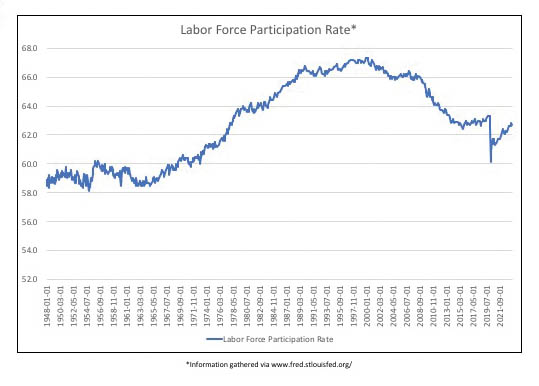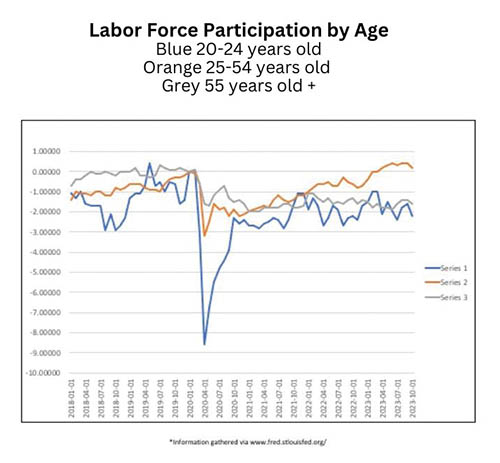— By Glen Greenawalt —
3 hospitality employment challenges facing the industry today.
It’s ironic that “Down Under,” the 1980s anthem about a group of Australians traveling the world, is by the band Men at Work. In the song, the protagonists clearly are not working — just like much of today’s working age U.S. population. What’s going on with employment trends, and how can hospitality employers get the workers needed to ensure guests get a guest experience? Here are the top three workforce challenges our team sees facing the industry today.
1. Quantity and quality of applicants
The hospitality industry has been in a staffing squeeze for years. There never seem to be enough candidates, and the quality isn’t always the best. You often hear people wondering how it can be that unemployment is so low, yet there are so many jobs left unfilled. The answer has a lot to do with a statistic called labor force participation. Unemployment measures how many people are looking for work but can’t find it. Labor force participation reflects how many people are working or looking for work.

Labor force participation peaked in 2000, as the first graph from the St. Louis Fed shows (Figure 1). Of course, it dipped during COVID, and while it’s slowly increased, it just hasn’t hit its stride. Part of the explanation is the large number of baby boomers retiring and not being replaced, but there’s more to the picture. The second graph (Figure 2) shows that while labor force participation for adults 25-54 has surpassed pre-pandemic levels, that for both younger and older adults it is still well below what it was in 2020. Many hospitality jobs traditionally are filled by younger adults, so having a significant percentage of them choosing to opt out of work puts a crimp in hiring.

When you’re casting your line into a pond with fewer fish, you won’t catch much if you’re using a bent pin and a fake worm as bait. What’s this analogy mean? In today’s hiring environment, with fewer candidates to choose from and lots of competition from other employers, you won’t get the best employees by using old hiring methods. Just putting out an ad, holding interviews and doing callbacks a few days later doesn’t work. Hiring happens quickly, and candidates expect more attention. Wages and salary are important, but so is engaging with candidates and promoting your workplace culture. Taking the time during the interview to learn what the candidate wants from the job and seeing how that meshes with your business needs can help you make good hires and promote retention.
2. Retaining good employees
Once you have a great employee, you want to keep them. According to Payscale, two of the biggest reasons employees stay in their jobs are good company culture and positive relationships with management.
Good company culture means more than free pizza on Fridays. It’s about creating an environment where employees feel valued and trusted. You talked up your company culture in your ads and interviews, so make sure the reality lives up to your promises.
Good management is another key way to build employee loyalty and retention. A caring manager can help young employees see how they contribute, how they provide value to the business. Guiding young employees to see their jobs that way — that they really do make a difference to the company — can help them view their job and themselves with more respect. Give them responsibilities in line with their abilities, but also challenge them to learn new skills.
3. Managing staffing costs
It’s Econ 101: supply is down, and demand is up, so prices for labor are rising. Wage inflation has been happening across the board in hospitality, sometimes at double the pay for the same job just a few years ago. That cost has to be carried by employers, but there are ways to hold down labor expenses while still providing excellent customer service. Fine-tuning your scheduling for different times of day and different days of the week so you only bring in the staff you need is a good approach. Using temps or temp-to-hire employees is another way to fill demands during peak periods. Getting coaching on your hiring methods, from how to write an engaging job description to how to target your hiring ads to the right markets, can produce valuable results.
Business is always changing, and keeping an eye to the future helps businesses stay competitive. Strong leaders recognize the changes happening today in the hiring space and are willing to embrace new models for the future. The best leaders anticipate future industry trends, and their businesses not only survive but thrive.
— Glen Greenawalt is COO and co-founder of LGC Hospitality, a national staffing firm headquartered in Indianapolis. LGC has offices in over 40 U.S. cities. Team members work with hotel and restaurant leadership to place executives and temporary workers.

